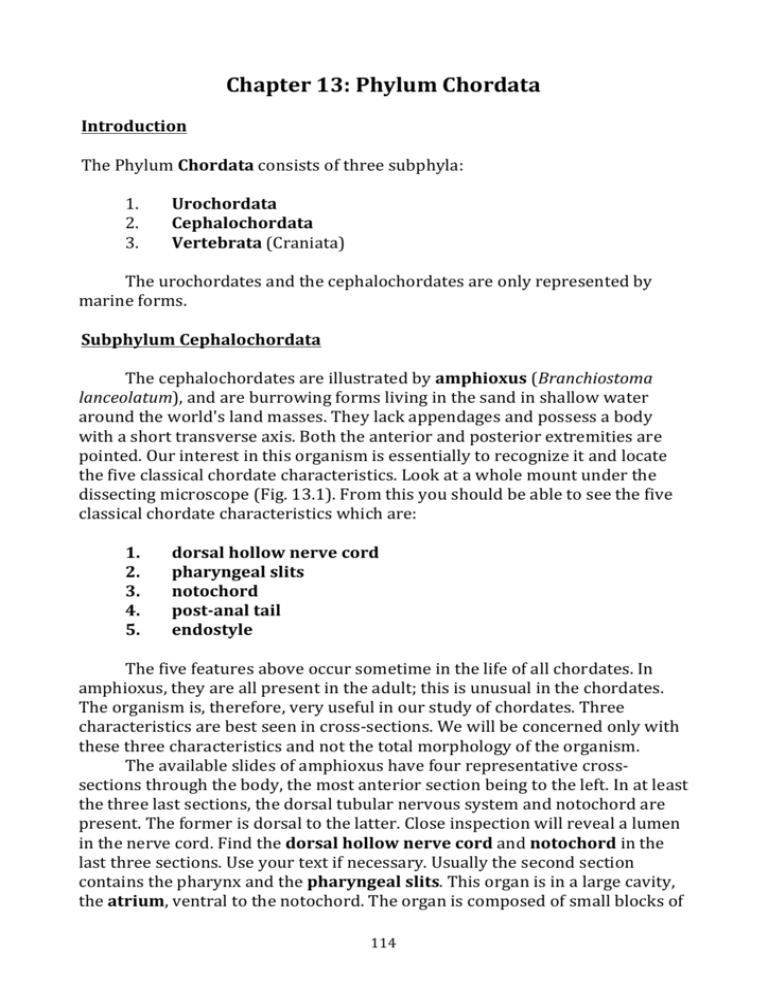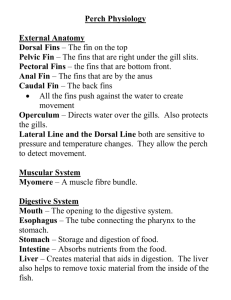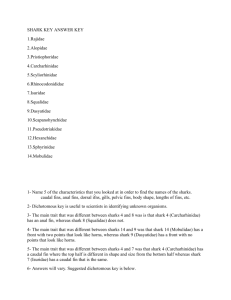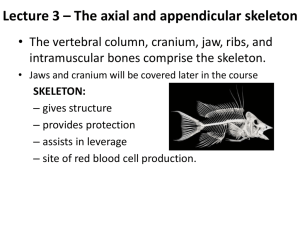Chapters 13 and 14
advertisement

Chapter 13: Phylum Chordata Introduction The Phylum Chordata consists of three subphyla: 1. Urochordata 2. Cephalochordata 3. Vertebrata (Craniata) The urochordates and the cephalochordates are only represented by marine forms. Subphylum Cephalochordata The cephalochordates are illustrated by amphioxus (Branchiostoma lanceolatum), and are burrowing forms living in the sand in shallow water around the world's land masses. They lack appendages and possess a body with a short transverse axis. Both the anterior and posterior extremities are pointed. Our interest in this organism is essentially to recognize it and locate the five classical chordate characteristics. Look at a whole mount under the dissecting microscope (Fig. 13.1). From this you should be able to see the five classical chordate characteristics which are: 1. dorsal hollow nerve cord 2. pharyngeal slits 3. notochord 4. post-­‐anal tail 5. endostyle The five features above occur sometime in the life of all chordates. In amphioxus, they are all present in the adult; this is unusual in the chordates. The organism is, therefore, very useful in our study of chordates. Three characteristics are best seen in cross-­‐sections. We will be concerned only with these three characteristics and not the total morphology of the organism. The available slides of amphioxus have four representative cross-­‐ sections through the body, the most anterior section being to the left. In at least the three last sections, the dorsal tubular nervous system and notochord are present. The former is dorsal to the latter. Close inspection will reveal a lumen in the nerve cord. Find the dorsal hollow nerve cord and notochord in the last three sections. Use your text if necessary. Usually the second section contains the pharynx and the pharyngeal slits. This organ is in a large cavity, the atrium, ventral to the notochord. The organ is composed of small blocks of 114 tissue, which collectively surround a lumen. The spaces between the blocks are the pharyngeal slits. As in most other lower chordates, the pharyngeal slits are exits for water taken into the pharynx from the mouth. They also provide spatial proximity between the oxygen-­‐carrying water and the blood capillaries in the walls of the pharynx. Figure 13.1. Amphioxus structures. Also be sure to study the amphioxus woodcuts and the microscopes slides. Note that the woodcuts are colored according to the classical embryological colors: blue for ectoderm, red for mesoderm, and yellow for endoderm. Recognize the germ layer from which each structure originates. Subphylum Urochordata The adult of this organism, the sea squirt, does not look like most chordates (Fig. 13.2). They are sessile as adults, and retain only the pharyngeal slits and Endostyle from the five chordate characteristics. The slits are numerous, and go through a large pharyngeal basket, which is housed in the atrium. Look at the plastic mount and the slides provided. The organism can be identified by two external openings, the incurrent and excurrent siphons. Look for these and the pharyngeal slits. Observe a preserved tunicate for siphons. To see the other two chordate characteristics, we must look at the larval stage (Fig. 13.3). This is a tadpole-­‐like organism. Look at the slide (Amaroecium tadpole), and notice the presence of two longitudinal structures in the tail. One of these is the notochord. Its presence in the tail-­‐only is responsible for the name of the subphylum. The nerve cord is dorsal to the notochord, and extends into the anterior portion of the body. 115 Figure 13.2. Adult urochordate structures. Figure 13.3. Larval urochordate. Subphylum Vertebrata (Craniata) • Vertebra replace notochord as a supporting structure • Vertebra surround nerve cord • Notochord remains or is replaced by centrum of vertebra 116 Superclass Agnatha Class Myxini: hagfish and slime hag (recently considered to no longer be a vertebrate) Class Cephalaspidomorphi: lampreys o Circular mouth, no jaws o No paired appendages o Cartilaginous vertebrae incomplete o More than five pharyngeal slits Lamprey: this organism possesses a circular, toothed, mouth that is adapted to its feeding habits of attaching to fish, rasping a hole in the scale covering, and feeding on the muscles. Observe this mouth in the preserved specimen and the plastic mount sagittal section of the anterior body. Laterally and posterior to the mouth, are several paired openings. These are actually openings from the gill pouches and there is a one-­‐to-­‐one correspondence between the more internal pharyngeal slits and the openings from the gill pouches. In the sagittal section and in the cross-­‐section embedded in plastic the dorsal tubular nervous system and notochord can be seen in their usual relationship. Ammocoetes: lamprey larva. Its name sounds a good deal like amphioxus, and its appearance is not unlike that of the cephalochordate. The cross-­‐ sections of ammocoetes are arranged similarly to those of amphioxus. Look through all the sections for the nerve cord and notochord. Compare x.s. of amphioxus and ammocoetes through the pharyngeal region. Be able to identify the gill slits and the endostyle. Superclass Gnathostomata: jawed organisms Class Chondrichthyes: sharks, rays, skates, chimaeras o Cartilaginous skeleton o Five pharyngeal slits plus a spiracle o Skull of one piece called a chondrocranium o Two pairs of paired appendages (pectoral, pelvic) o Paired jaws o Placoid scales in the integument Subclass Elasmobranchii: sharks, skates, and rays. 117 Subclass Holocephali: chimaeras Ovoviviparity: The young of sharks hatch in the body of the maternal parent and are born as fully-­‐living organisms. Look at the provided specimens of young dissected from the uterus of the mother. Notice the attached yolk sac. Class Osteichthyes: bony fish o bony skeleton o fin rays o teeth usually fused to jaws o swim bladder or lung often present Subclass Actinopterygii: ray finned fishes Paired fins supported by rays without a lobed portion Infraclass Holostei • Order Lepisosteiformes: gars – seven living species o multilayered and interlocking ganoid scales o elongated jaws o Look at the mounted gar hung on the wall on the western end of DW Reynolds on the first floor. In addition, we have two dried specimens and a skull available for examination in the lab. • Order Amiiformes: bowfin – single species o mobile maxilla o cycloid scales o Observe the bowfin skull and specimen. Infraclass Teleostei Superorder Elopomorpha • have specialized larva called leptocephalus (“leafy head”) larva • most are marine • eel-­‐like in morphology • cycloid scales Order Elopiformes: tenpounders and ladyfish o pectoral fins ventrolateral o pelvic fins abdominal o dorsal fin at level of pelvic fins o anal fin present 118 o anal fin closer to caudal fin (vs. Cypriniformes) o body slender, usually compressed o caudal fin deeply forked Order Anguilliformes: eels o lack pelvic fins and pelvic girdle o body is very elongated o pectoral fins (when present) are midlateral in position o anal fins are usually long and usually connect with caudal fin o scales can be absent o Check out the tenpounder, ladyfish, and eel specimens. Superorder Ostariophysi • Weberian apparatus – small bones that connect gas bladder to inner ear • males have nuptial tubercles – composed of epidermal cells; • provide friction that helps to keep breeding fishes in contact • catfish have adipose fin – near tail on dorsal surface • cycloid scales Order Cypriniformes: minnows, shiners, and goldfish o pectoral fins ventrolateral o pelvic fins abdominal o dorsal fin at level of pelvic fins o pelvic fins closer to anal fin (vs. Elopiformes) o mouth (jaws and palate) always toothless o adipose fin absent o head almost always scaleless o lepidotrichia in dorsal fins of some species Order Siluriformes: catfishes o no scales o body is naked or covered in bony plates o may have up to four pairs of barbels (whiskers) o use barbels for detecting food o eyes are generally small 119 Superorder Acanthopterygii • modified protrusible jaws • many have upturned mouths • ctenoid scales Order Antheriniformes: silversides o pectoral fins are lateral o pelvic fins are abdominal o two dorsal fins o anal fin is long – spans distance of both dorsal fins o ceratotrichia in first dorsal fin o anal fin – one anterior lepidotrichia o lateral line is weak or absent o Atheriniform larvae – gut is short, single row of melanophores along back, and fin rays do not become apparent until some time after hatching • Order Beloniformes: needlefishes o pectoral fins are lateral o pelvic fins are abdominal o dorsal fin at level of anal fin o caudal fin is not forked o lower caudal fin lobe with more fin rays than upper lobe o elongated jaws o upper jaw is fixed or nonprotrusible • Order Perciformes: perches, batfishes, marlin, tunas, and darters o pectoral fins are lateral o pelvic fins are positioned by the throat or under the belly o pelvic fins are at the level of the pectoral fins o dorsal and anal fins with anterior lepidotrichia and posterior ceratotrichia o pelvic fins with one lepidotrichia and up to five ceratotrichia o scales are usually ctenoid, but are sometimes cycloid Order Pleuronectiformes: flounder 120 o in many species, both eyes lie on one side of the head o laterally compressed body o protrusible eyes o dorsal fin extends onto head Order Tetraodontiformes: puffer fish, boxfish o body is inflexible o undulation is limited to caudal fin o scales are modified into strong plates or spines o or scales are lost and skin is tough and leathery o bones of jaw fused into a “beak” Order Syngnathiformes: seahorses and pipefish o body elongate and encased in a series of bony rings o mouth small, at end of tube-­‐shaped snout o pelvic fins, when present, abdominal o no anal fin o upper jaw not protractile Subclass Saropterygii: lobe-­‐finned fishes Fins have lobes with large heavy bones for support. Lung often present. Higher Chordates Class Amphibia o Scaleless, moist glandular skin o Four appendages for locomotion on land. Substantial musculature in appendages, not just at the base as in fins. o Three-­‐chambered heart o Can raise or lower head-­‐-­‐two articulations with skull (occipital condyles) and vertebral column Order Caudata: salamanders Well developed tail Order Anura: frogs and toads Tailless Hind legs adapted to jumping 121 Order Gymnophiona: caecilians Class Reptilia o Scaled, virtually glandless skin o Amniote eggs o Three-­‐chambered heart (except crocodilians which have four chambers) Subclass Anapsida: extinct no temporal openings in the skull Subclass Diapsida two temporal openings in the skull Order Testudines: turtles • Body enclosed by upper shell (carapace) and lower shell (plastron) Superorder Lepidosaria Order Squamata: lizards and snakes • Skin of plates or scales that is shed periodically Suborder Lacertilia: lizards o Eyelids and external ear openings o Legs usually present Suborder Serpentes: snakes o No eyelids or external ear openings o Legs vestigial or absent Order Spenodonta: tuataras Order Icthyosauria: ichthyosaurs Superorder Sauropterygia Superorder Archosauria: ruling reptiles Order Plesiosauria: plesiosaurs Order Thecodontia: early archosaurs 122 Order Crocodilia: crocodiles and alligators • Elongate, massive skull • Sprawling body form Order Pterosauria: pterosaurs Order Ornithischia: bird-­‐hipped dinosaurs Order Saruichia: reptile-­‐hipped dinosaurs Suborder Sauropodomorpha: sauropods • Lizard feet forms Suborder Theropoda: theropods • Beast feet forms Subclass Synapsida: mammal-­‐like reptiles Order Pelycosauria: diametrodon Order Therapsida Class Aves o Feathers over body, scales on legs o Bursa of Fabricius o Anterior appendages modified into wings for flying o Bill present, no teeth Subclass Archaeornithes: “long, old tail” Subclass Neornithes: “short, new tail” Superorder Paleognathae: “old beak” Superorder Neognathae: “new beak” Class Mammalia o Body with hair and skin glands o Female with functional mammary glands o Lower jaw is a single bone called a dentary (mandible) o Teeth diversity: heterodont dentition 123 Subclass Prototheria: egg-­‐laying mammals Order Monotremata: platypus Subclass Theria: viviparous mammals Infraclass Metatheria: marsupials Infraclass Eutheria: chorio-­‐allantoic placenta Order Insectivora: shrews and moles Order Chiroptera: bats Order Primates: monkeys and humans Order Cingulata: armadillos Order Pilosa: sloths Order Lagomorpha: rabbits Order Rodentia: rodents Order Carnivora: carnivores Order Hyracoidea: hyraxes Order Proboscidea: elephants Order Sirenia: manatees Order Perissodactyla: odd-­‐toed ungulates Order Artiodactyla: even-­‐toed ungulates and whales 124 Chapter 14: Anatomy of the Perch Introduction The Yellow Perch (Perca flavens) is a common fresh-­‐water fish found throughout North America. It is a generalized fish, without a great degree of specialization, and therefore makes a good representative for fish anatomy. By performing the perch gross dissection and examining the perch skeleton, in combination with the guppy histological slides, one can gain an excellent appreciation for how a vertebrate is constructed. Skeleton Fish have a variety of fins that are used for locomotion, balance, display, and defense. In a typical Actinopterygiian fish, the fins have bony supports (fin rays) in each fin. Two types of fin rays are present in the skeleton of the perch. Lepidotrichia are ossified fin rays and are sometimes called fin spines. Ceratotrichia are unossified and are therefore called soft fin rays. The anterior dorsal fin is composed entirely of lepidotrichia, while only the first two fin rays in the posterior dorsal fin are ossified. The remaining supports in this fin are ceratotrichia. The anal fin demonstrates an identical construction to the posterior dorsal fin, and the caudal fin is completely composed of ceratotrichia. In the perch, the caudal fin is the main locomotor fin, while the others, including the pectoral and pelvic fins, control the orientation of the fish in the water. Note the pelvic girdle and the pectoral girdle that support the two respective fins. Examine the preserved lungfish for a comparison of fin structure seen in a Saropterygiian (lobe-­‐finned) fish. The fin rays in the dorsal, anal, pectoral, and pelvic fins are supported at their bases by a bone, or a series of bones, known as pterygiophores. The pterygiophores that support the dorsal fins are simple, ventrally tapering elements. The tips of the dorsal fin pterygiophores extend ventrally into the connective tissue between the two halves of the neural spines. The bony elements supporting the anal fin are similar in construction, but taper dorsally and attach to the hemal spines. However, the anterior few pterygiophores (usually the first two) fuse into a large element that extends dorsally to attach to one or two ventral ribs. The caudal (tail) fins of fish vary in their morphology. The perch exhibits a tail with two equal-­‐sized lobes, but its vertebral column extends into the upper lobe. This condition is known as homocercal. Compare the perch’s tail to the caudal fin of the shark on display. Shark tails have larger upper lobes and smaller lower lobes. However, like the perch, the shark’s vertebral column extends into the upper lobe, and this construction is known as heterocercal. 125 Finally, compare the perch and shark tails to the caudal fin of the lungfish. Here, the lobes are equal in size, but the vertebral column remains horizontal and does not extend into the upper lobe. Lungfish tails are called diphycercal. Examine the long vertebral column that runs along the length of the perch’s body. There are two main types of vertebrae in fish, the trunk vertebrae, which are found anteriorly and the posterior caudal vertebrae. Each vertebra is composed of three structures, the centrum, neural arch, and hemal arch. The centrum almost completely replaces the notochord during development (note it is still a notochord in the guppy slides). The neural arch surrounds the spinal cord, and the hemal arch surrounds the caudal blood vessels. The trunk and caudal vertebrae can be differentiated by the presence or absence of spines associated with the arches. Both vertebrae types bear neural spines, but only the caudal vertebrae have hemal spines. Both types of spines are attachment points for muscle tissue. The trunk vertebrae bear ribs, in lieu of hemal spines, and there are two types in the perch, dorsal and ventral ribs. The curved ventral ribs are more prominent, while the more delicate dorsal ribs extend laterally. The skull anatomy of fish is very complex and will not be covered completely in this class. However, there are a few important bones you will need to know. The premaxilla and maxilla form the upper jaw and are free from the skull. This condition is unlike that found in many other animals, such as mammals, where both bones are fused to the skull and are immobile. The most posterior portion of the upper jaw is composed of the quadrate. The lower jaw is formed by the dentary and the articular, and it articulates with the skull through the hyomandibula and the symplectic bones. This type of jaw attachment is known as modified hyostyly. The gills are the main respiratory and osmoregulatory organs of the fish. The operculum is the covering that protects the fragile gills from physical injury. Note the opercular bone. Gross Anatomy Examine the entire fish before dissection. Please note the various fins that you identified in the skeleton. The lateral line runs from just posterior to the operculum to the caudal fin. It is sensitive to water pressure and is used to sense the environment around the fish, especially in murky waters where visibility is reduced. Branchiostegal rays can be seen under the operculum. The mouth is terminal in the perch, and two nostrils are present on either side of the head, anterior to the eyes. The opercular bone (operculum) covers the gills, and the gill slit or opercular opening is found at its posterior margin. The anus is positioned anteriorly to the anal fin and the urogenital opening (cloaca) is found posterior to the anus. One of the most distinctive external features of most fish are scales. The scales of fish develop within the dermis of their skin and, therefore, are known 126 as dermal scales. Actinopterygiian fish can exhibit three types of scales, ganoid, cycloid, and ctenoid. Ganoid scales have an outer layer of enamel that is laid down on top of lamellar bone. This type of scale is found on gars. Cycloid and ctenoid scales are both composed of lamellar bone. Perch exhibit ctenoid scales. Compare the morphology of these three scale types to each other and to that of placoid scales (Class Chondrichthyes) by looking at the available prepared slides. Carefully cut away the operculum to expose the gills. Note the pharynx, which is the space the between the mouth and esophagus. On each gill, there are numerous gill filaments where gas and ion exchange occur. The gills are supported by branchial (pharyngeal) arches, of which there are four. The most anterior arch, and the gill it supports, should be plainly visible. To see the other three arches, pull the first arch laterally and separate the individual arches. Gill rakers, projections that extend inward across the pharyngeal slits, should be visible on the first arch. These structures help in feeding by preventing prey (and debris) from passing through the pharyngeal openings and escaping. With a scalpel, make a shallow cut from the anus anteriorly between the pelvic fins to the point where the gills join together. Next, cut from the anus dorsally and anteriorly until the body wall covering the abdominal cavity is removed. Often the gonads are very large in the perch. Please note the ovary (single) or testes (paired) that should be easily visible in the posterior portion of the pleuroperitoneal cavity. Please remove the gonad(s). The large organ lining the dorsal side of the body cavity is the swim bladder. The digestive system is the most obvious system visible. Follow it anterior to posterior and identify the pharynx, esophagus, stomach, duodenum, pyloric ceca, small intestine, and rectum. Just ventral to the stomach and anterior to the duodenum note the liver and gall bladder. A thin strip of dark tissue located dorsal to the swim bladder is the kidney The transverse septum separates the pleuroperitoneal cavity from the pericardial cavity where the heart is located. Please identify the sinus venosus, atrium, ventricle, bulbous arteriosus, and ventral aorta. There are several miscellaneous structures to be aware. Note that the muscle tissue in fish is segmented and forms a “zig-­‐zag” like pattern. Each “zig-­‐zag” is called a myomere, and myomeres are separated from each other by sheets of connective tissue known as myosepta. This construction is an ancestral vertebrate trait that disappears in the adults of terrestrial vertebrates, but is still visible in their embryos. In the most anterior-­‐dorsal portion of the body cavity is the head kidney, which is the main producer of red blood cells in fish. In other vertebrates, this function is performed by the bone marrow. Just ventral and posterior to the stomach is the spleen where white blood cells mature. 127







